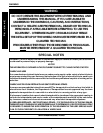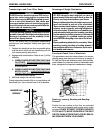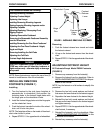
6
GENERAL GUIDELINESPROCEDURE 1
GENERAL WARNINGS (CONTINUED)
Carefully read battery/battery charger information prior to installing, servicing or operating your wheel-
chair.
GROUNDING INSTRUCTIONS:
DO NOT, under any circumstances, cut or remove the round grounding prong from any plug used with
or for Invacare products. Some devices are equipped with three-prong (grounding) plugs for protection
against possible shock hazards. Where a two-prong wall receptacle is encountered, it is the personal
responsibility and obligation of the customer to contact a qualified electrician and have the two-prong
receptacle replaced with a properly grounded three-prong wall receptacle in accordance with the
National Electrical Code. If you must use an extension cord, use ONLY a three-wire extension cord having
the same or higher electrical rating as the device being connected. In addition, Invacare has placed
RED/ORANGE WARNING TAGS on some equipment. DO NOT remove these tags.
RAIN TEST
INVACARE has tested it’s power wheelchairs in accordance with ISO 7176 Part 9 “Rain Test”. This provides
the end user or his/her assistant sufficient time to remove his/her power wheelchair from a rain storm and
retain wheelchair operation.
DO NOT leave power wheelchair in a rain storm of any kind.
DO NOT use power wheelchair in a shower or leave it in a damp bathroom while taking a shower.
DO NOT leave power wheelchair in a damp area for any length of time.
Direct exposure to rain or dampness will cause the chair to malfunction electrically and mechanically;
may cause the chair to prematurely rust.
Check to ensure that the battery covers are secured in place, joystick boot is NOT torn or cracked where
water can enter and that all electrical connections are secure at all times.
DO NOT use the joystick if the boot is torn or cracked. If the joystick boot becomes torn or cracked,
replace IMMEDIATELY.
WEIGHT TRAINING
Invacare DOES NOT recommend the use of its wheelchairs as a weight training apparatus. Invacare
wheelchairs have NOT been designed or tested as a seat for any kind of weight training. If occupant uses
said wheelchair as a weight training apparatus, INVACARE SHALL NOT BE LIABLE FOR BODILY INJURY AND
THE WARRANTY IS VOID.
WEIGHT LIMITATION
The Pronto
R2-250 Series
models and the Pronto
R2
models that have motors with clutches have a weight
limitation of 250 lbs.
The Pronto
R2
models that have motors with motor locks have a weight limitation of 300 lbs.
The Pronto
R2
models that have motors with motor locks AND have the heavy duty crossbrace on the
battery tray have a weight limitation of 400 lbs.
CAUTION: IT IS VERY IMPORTANT THAT YOU READ THIS INFORMATION REGARDING THE POSSIBLE EFFECTS
OF ELECTROMAGNETIC INTERFERENCE ON YOUR POWERED WHEELCHAIR.
Electromagnetic Interference (EMI) From Radio Wave sources
Powered wheelchairs and motorized scooters (in this text, both will be referred to as powered wheel-
chairs) may be susceptible to electromagnetic interference (EMI), which is interfering electromagnetic
energy (EM) emitted from sources such as radio stations, TV stations, amateur radio (HAM) transmitters,
two way radios, and cellular phones. The interference (from radio wave sources) can cause the pow-
ered wheelchair to release its brakes, move by itself, or move in unintended directions. It can also
permanently damage the powered wheelchair's control system. The intensity of the interfering EM
energy can be measured in volts per meter (V/m). Each powered wheelchair can resist EMI up to a
certain intensity. This is called its "immunity level." The higher the immunity level, the greater the protec-
tion. At this time, current technology is capable of achieving at least a 20 V/m immunity level, which
would provide useful protection from the more common sources of radiated EMI. This powered wheel-
chair model as shipped has an unknown immunity level.
G
E
N
E
R
A
L
G
U
I
D
E
L
I
N
E
S
WARNING


















